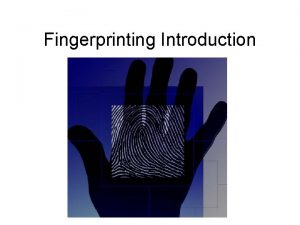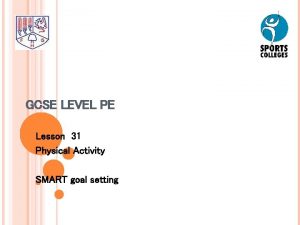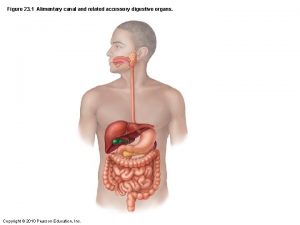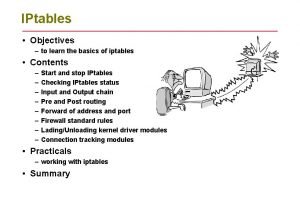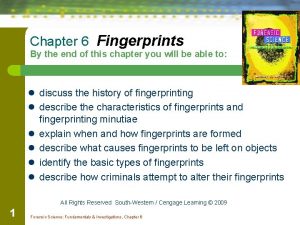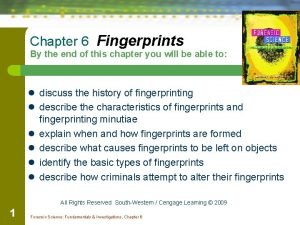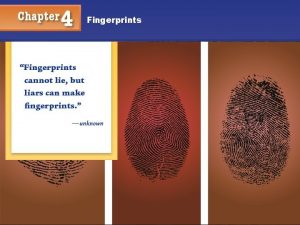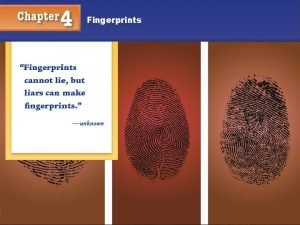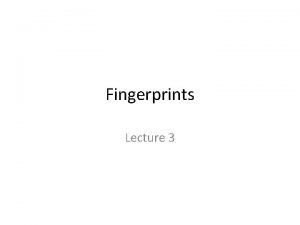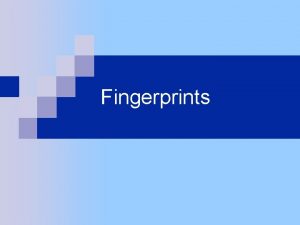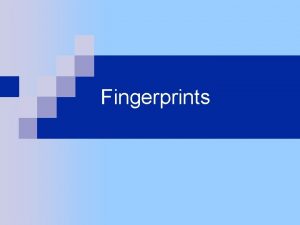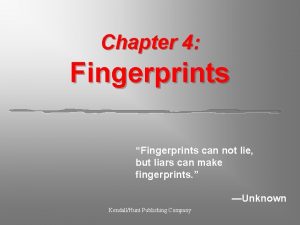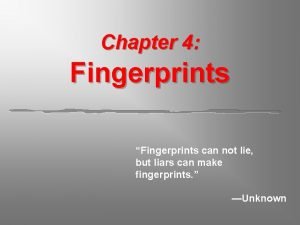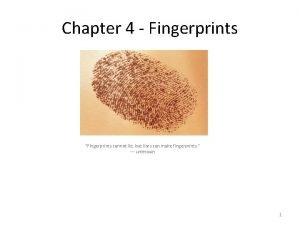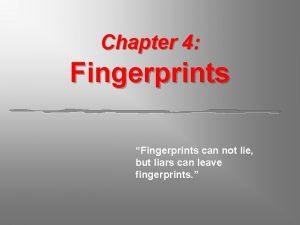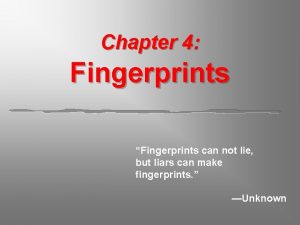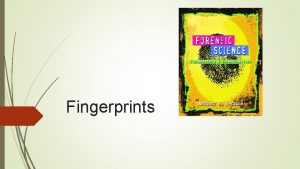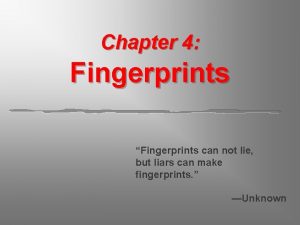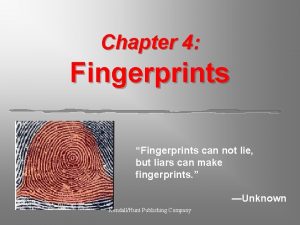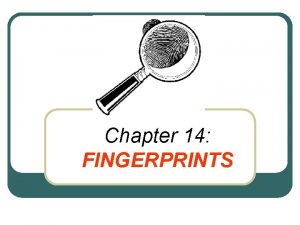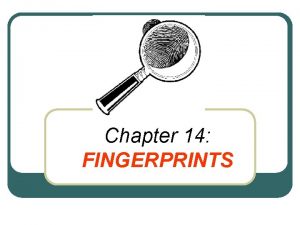Fingerprints Fingerprints Learning Targets Chapter 6 Discuss the







































- Slides: 39

Fingerprints

Fingerprints Learning Targets Chapter 6 Discuss the history of fingerprinting Describe the characteristics of fingerprints and fingerprinting minutiae Explain when and how fingerprints form Describe how fingerprints can be left on objects Identify the basic types of fingerprints Describe how criminals attempt to alter their fingerprints

Learning Targets Determine the reliability of fingerprints as a means of identification Describe the Integrated Automated Fingerprint Identification System (IFAIS) Explain how fingerprint evidence is collected Describe the latest identification technologies Determine if a fingerprint matches a fingerprint on record Use the process of lifting a latent print

History of Fingerprinting First known use: nearly 4000 years as signatures on clay tablets.

History of Fingerprinting In late 1700’s, Andreas Mayer first noted that no two fingerprints are the same.

History of Fingerprinting In 1856, Herschel noted that they didn’t change with age.

History of Fingerprinting In 1879, Bertillon began keeping fingerprints of criminals in police files.

History of Fingerprinting In 1888, Galton developed the fingerprint classification system in use today.

History of Fingerprinting �In 1896, the ten card was invented, allowing them to be used in criminal investigations from then on.

Which leads to … Three fundamental principles that fingerprints follow: A fingerprint is an individual characteristic; no two people have been found with the exact same fingerprint pattern. A fingerprint pattern will remain unchanged for the life of an individual; however, the print itself may change due to permanent scars and skin diseases. Fingerprints have general characteristic ridge patterns that allow them to be systematically identified.

Principle One Mathematically, the probability for the existence of two identical fingerprint patterns in the world’s population is extremely small. No two fingerprints have been found to be identical. The individuality of a fingerprint is not determined by its general shape or pattern, but by the careful study of its ridge characteristics, known as minutiae.

Principle One (cont. ) It is the identity, number, and relative location of these minutiae that gives individuality to a fingerprint. There as many as 150 minutiae on the average finger. In a court proceeding, an expert must demonstrate a point-by-point comparison in order to prove the identity of an individual.

Principle Two The epidermis is the outer layer of the skin, while the dermis is the inner layer of the skin. The dermal papillae is a layer of cells between the epidermis and dermis, that is responsible for determining the form and pattern of the ridges on the surface of the skin. Once the dermal papillae develop in the human fetus, the ridge patterns will remain unchanged throughout life except to enlarge during growth.

What is a Fingerprint? Our skin has ridges on the surface to help us grip things. Water, oil, and salt from our glands mix with dirt in the environment and stick to everything we touch, leaving a fingerprint. Dactyloscopy is the study of fingerprint identification. Police investigators are experts in collecting “dactylograms”, otherwise known as fingerprints.

Principle Three All fingerprints are divided into three classes on the basis of their general pattern: loops, arches, and whorls (L. A. W. ).

Characteristics of Fingerprints Three main types: Loop - most common, about 65% of all prints ▪ Loops must have one delta and one or more ridges that enter and leave on the same side. These patterns are named for their positions related to the radius and ulna bones. NOTE: On Delta Ulnar Loop (Right Thumb) Loop opens toward right or the ulna bone. Radial Loop (Right Thumb) Loop opens toward the left or the radial bone. the left hand, a loop that opens to the left would be an ulnar loop, while one that opens to the right would be a radial loop.

Radius and Ulna

Arches – About 5% of all fingerprints. Arches are the simplest type of fingerprints that are formed by ridges that enter on one side of the print and exit on the other. No deltas are present. Spike or “tent” Plain Arch Ridges enter on one side and exit on the other side. Tented Arches Similar to the plain arch, but has a spike in the center.

Whorls – About 30% of all prints Whorls have at least one ridge that makes (or tends to make) a complete circuit. They also have at least two deltas. If a print has more than two deltas, it is most likely an accidental. Plain Whorl Central Pocket Whorl Draw a line between the two deltas in the plain and central pocket whorls. If some of the curved ridges touch the line, it is a plain whorl. If none of the center core touches the line, it is a central pocket whorl.

Whorls – Part 2 Double Loop Whorl Accidental Whorl Delta Double loop whorls are made up of any two loops combined into one print. Accidental whorls contain two or more patterns (not including the plain arch), or does not clearly fall under any of the other categories.

TTYP: Identify the fingerprints! Show of fingers: Identify these: L hand Whorl Arch Loop (radial)

Identify These! R hand Loop (ulnar) R hand Loop (radial) Whorl

Identify These! L hand Loop (radial) L hand Loop (ulnar) Whorl

Minutiae Examples You must be able to match at least 12 points of identification for a match

Evidence Types Three types of prints can be found: Patent fingerprints –visible prints left when fingers have a liquid (such as blood) on them. Plastic fingerprints –are visible, impressed prints that occur when a finger touches a soft, malleable surface resulting in an indentation

Latent fingerprints – hidden prints that can be made visible with special techniques. All fingerprints are individual evidence.

Can Fingerprints Be Changed? Many criminals have tried, using chemicals or fire. Most end up with even more recognizable prints because of differences in the scarring patterns.

How Are Fingerprints Analyzed? AFIS (Automated Fingerprint Identification System) has more than 47 million prints on file. Digital searches take about two hours, and provide a list of “possibles” which are then compared by technicians.

Methods to Collect Fingerprints Latent prints can be made visible with carbon or talc, and then collected on tape.

Methods to Collect Fingerprints Ninhydrin can be sprayed on paper. It reacts with amino acids in sweat to leave a purple print.

Methods to Collect Fingerprints Cyanoacrylate (super glue) can be heated in a vapor tent. It sticks to amino acids to get fingerprints on glass, plastic, metal, and skin.

Methods to Collect Fingerprints Wood or Styrofoam objects can be dipped or sprayed with silver nitrate. It reacts with chloride in the salty sweat to show a print.

Methods to Collect Fingerprints Iodine can be heated in a vapor tent or a fuming gun to get prints off of paper, cardboard, and unpainted surfaces. It fades and must be photographed.

Methods to Collect Fingerprints Fluorochromes can be sprayed on non- porous items and then viewed with UV light.

The Future of Fingerprint Technology Scanning technology can show tiny pore patterns on ridges for better matching.

The Future of Fingerprint Technology Other physical features such as eye and facial patterns are being used to identify people.

The Future of Fingerprint Technology Trace evidence in fingerprints is being used to identify traces of explosives or drugs.

. . . Summary. . Fingerprints have long been used for identification, and in the mid-1800 s were recognized as unique to each person. Three main groups include arches, whorls, and loops. Basic analysis includes looking for cores and deltas and making a ridge count. Forensic Science: Fundamentals & Investigations, 38 Chapter 6

. . . . Summary Investigators search for patent, plastic, and latent prints. Dusting with powders or using special chemicals can make latent fingerprints visible. New developments may eliminate errors by analysts. Forensic Science: Fundamentals & Investigations, 39 Chapter 6
 Writing learning targets
Writing learning targets Agonist antagonist muscles
Agonist antagonist muscles Druggist fold definition
Druggist fold definition Knowledge targets
Knowledge targets Learning targets knowledge, reasoning, skill product
Learning targets knowledge, reasoning, skill product Learning targets helping students aim for understanding
Learning targets helping students aim for understanding Fundamental principles of fingerprint
Fundamental principles of fingerprint Amateurs talk tactics professionals talk logistics
Amateurs talk tactics professionals talk logistics Identifying market segments and targets chapter 9
Identifying market segments and targets chapter 9 Identifying market segments and targets chapter 9
Identifying market segments and targets chapter 9 Identifying market segments and targets chapter 9
Identifying market segments and targets chapter 9 Cuadro comparativo e-learning m-learning b-learning
Cuadro comparativo e-learning m-learning b-learning Efficient warehouse operations
Efficient warehouse operations Racial etiquette region
Racial etiquette region Brides magazine targets consumers who are in
Brides magazine targets consumers who are in Targets of change
Targets of change Smart gcse pe
Smart gcse pe Nyseslat levels
Nyseslat levels The nfl targets several different market segments
The nfl targets several different market segments Attainment targets barbados
Attainment targets barbados Five patterns of target market selection
Five patterns of target market selection Physical targets
Physical targets Icsa idsc 모니터링 접근방식
Icsa idsc 모니터링 접근방식 Segment invasion plan
Segment invasion plan Pituitary hormones and their targets
Pituitary hormones and their targets Digestive system
Digestive system Europe 2020 targets
Europe 2020 targets Europe 2020 targets
Europe 2020 targets Smarter balanced claims and targets
Smarter balanced claims and targets On training targets for supervised speech separation
On training targets for supervised speech separation Iptables targets
Iptables targets Single segment concentration
Single segment concentration Chapter 6 fingerprints
Chapter 6 fingerprints Forensic science fundamentals and investigations chapter 6
Forensic science fundamentals and investigations chapter 6 Chapter 6 fingerprints
Chapter 6 fingerprints Hình ảnh bộ gõ cơ thể búng tay
Hình ảnh bộ gõ cơ thể búng tay Lp html
Lp html Bổ thể
Bổ thể Tỉ lệ cơ thể trẻ em
Tỉ lệ cơ thể trẻ em Voi kéo gỗ như thế nào
Voi kéo gỗ như thế nào






